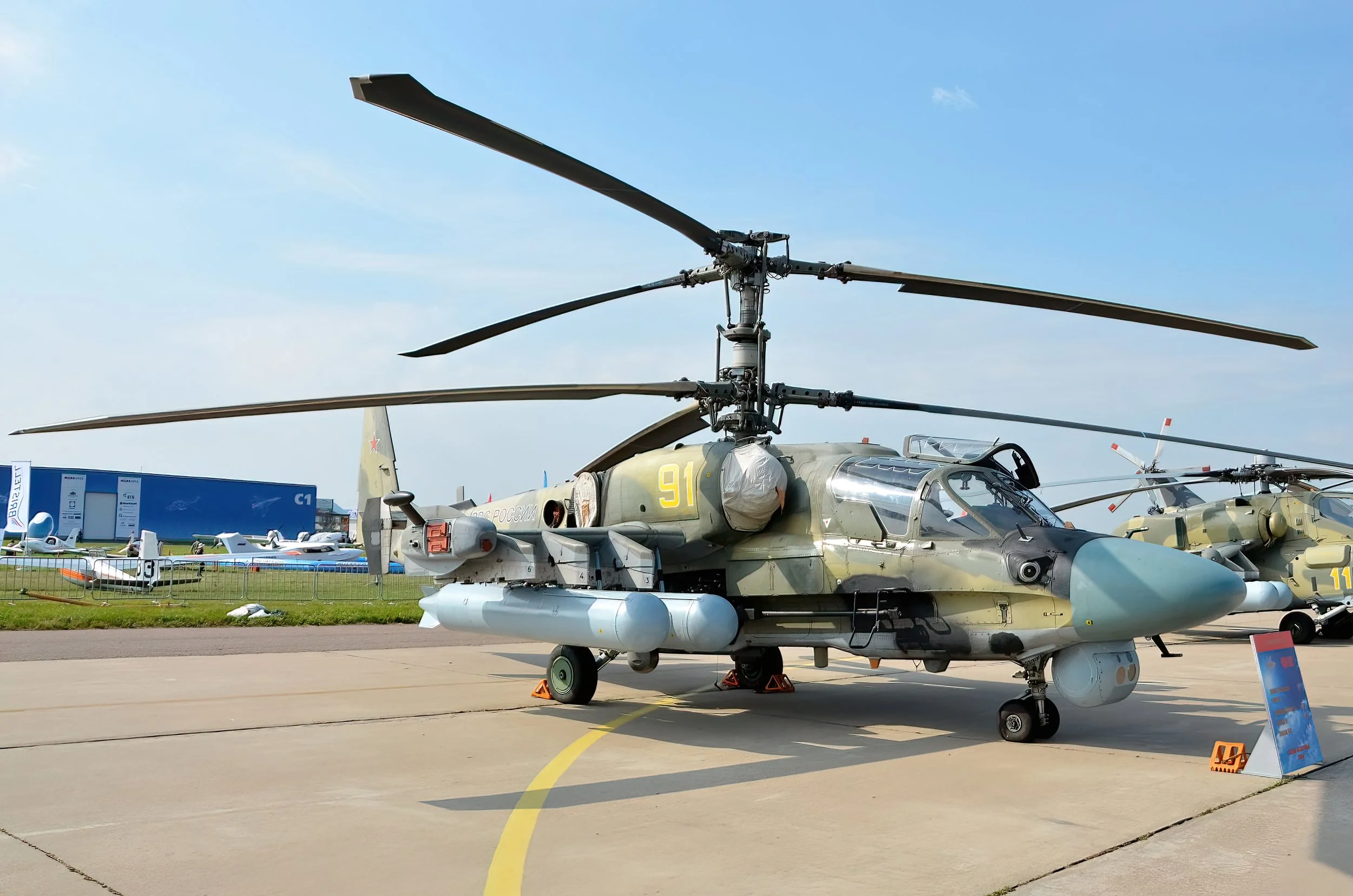
June 25 / Kamov Ka-52 first flight
First Flight 25 June 1997
Kamov Ka-52 Alligator
The Kamov Ka-52 Alligator, a formidable attack helicopter developed by the Russian company Kamov, has a rich history and impressive capabilities. Recognized for its dual-seat configuration, advanced avionics, and high combat survivability, the Ka-52 Alligator is a versatile aircraft designed for reconnaissance, target designation, and anti-tank missions. Its sleek design and powerful weaponry make it a standout performer at airshows, showcasing the innovation and technology behind Russia's military aviation industry.
Origins and Development:
The Kamov Ka-52 Alligator, initially designated as the Kamov Ka-50-2, emerged as a derivative of the Kamov Ka-50 Hokum single-seat attack helicopter. The development of the Ka-52 began in the late 1980s in response to the need for a two-seat variant with enhanced capabilities for the Russian Armed Forces.
First Flight and Introduction:
The prototype Ka-52 Alligator took to the skies for the first time on June 25, 1997, showcasing its advanced design features and combat capabilities. The helicopter was officially introduced into service with the Russian military in 2011, marking a significant milestone in modernizing Russia’s rotorcraft fleet.
Design Features:
The Ka-52 Alligator boasts a coaxial rotor system, a distinctive feature of Kamov helicopters, which provides excellent manoeuvrability, stability, and agility in various combat scenarios. The helicopter is equipped with advanced avionics, sensors, and weapon systems, making it a versatile and lethal platform for a wide range of missions.
Combat Capabilities:
The Ka-52 Alligator is designed primarily for anti-tank warfare, close air support, reconnaissance, and escort missions. It is armed with a potent array of weapons, including a 30mm cannon, anti-tank guided missiles, rockets, and air-to-air missiles, enabling it to engage ground and air targets with precision and firepower.
Operational Deployment:
The Ka-52 Alligator has seen operational deployment in various conflicts and military operations, including combat missions in Syria, where it demonstrated its effectiveness in engaging hostile targets and providing aerial support to ground forces. Its advanced sensors and targeting systems make it a valuable asset in modern asymmetric warfare scenarios.
Technological Advancements:
The Ka-52 Alligator incorporates cutting-edge technology, such as a glass cockpit, helmet-mounted targeting systems, and electronic countermeasures, enhancing situational awareness and survivability in complex battlefield environments. The helicopter’s advanced communication systems enable seamless coordination with ground forces and other aircraft.
Export and International Cooperation:
The Ka-52 Alligator has garnered interest from international customers seeking a high-performance attack helicopter. Russia has offered the helicopter for export, showcasing its capabilities to potential foreign buyers interested in acquiring a modern and combat-proven rotorcraft for their armed forces.
Future Prospects:
As the Ka-52 Alligator continues to serve as a key asset in Russia’s rotary-wing fleet, ongoing upgrades and enhancements are planned to further improve its combat effectiveness and operational readiness. The helicopter’s role in modern warfare and its adaptability to evolving threats highlight its enduring relevance in the ever-changing landscape of military aviation.
Conclusion:
The Kamov Ka-52 Alligator stands as a testament to Russian engineering prowess, showcasing innovation, combat effectiveness, and technological sophistication in the realm of attack helicopters. With its impressive capabilities and proven performance in combat operations, the Ka-52 Alligator remains a formidable asset for the Russian military and a symbol of excellence in rotary-wing aviation.
Ka-52 Alligator Facts
Stealthy Design: The Ka-52 Alligator incorporates stealth features, such as radar-absorbing materials and reduced infrared signatures, making it harder for enemy detection systems to track, giving it a strategic advantage on the battlefield.
Night Hunter: Known as the “Night Hunter,” the Ka-52 Alligator boasts advanced night vision and infrared sensors, allowing it to operate covertly under the cover of darkness, striking with precision and stealth.
Dual Crew Coordination: With a tandem seating arrangement for the pilot and gunner, the Ka-52 Alligator facilitates seamless communication and coordination between the crew, enhancing operational efficiency and combat effectiveness.
Adaptive Armor: The Ka-52 Alligator features adaptive armor panels that adjust based on the threat level, providing optimal protection without compromising agility, ensuring crew safety in high-risk environments.
High-Speed Maneuvers: Capable of reaching speeds up to 300 km/h, the Ka-52 Alligator’s agility and speed allow for rapid response and dynamic maneuvers, making it a formidable force in combat situations.
Cutting-Edge Avionics: Equipped with an all-digital glass cockpit and advanced avionics systems, the Ka-52 Alligator offers pilots real-time data, enhancing situational awareness and mission execution precision.
Precision Firepower: The Ka-52 Alligator’s side-mounted 30mm cannon, controlled by the gunner, provides rapid and accurate firepower against ground targets, ensuring precise engagement and effective close air support.
Versatile Weapon Mounts: Featuring modular weapon mounts, the Ka-52 Alligator can be swiftly reconfigured with various weapon systems, from anti-tank missiles to air-to-air rockets, adapting to diverse mission requirements with ease.
Operational Flexibility: Designed for multi-role operations, including reconnaissance, anti-tank warfare, and escort missions, the Ka-52 Alligator excels in diverse combat scenarios, showcasing its adaptability and effectiveness.
Export Success: With international interest from countries like Egypt and Algeria, the Ka-52 Alligator’s export success underscores its advanced capabilities and proven performance, solidifying its reputation as a top-tier attack helicopter on the global stage.



